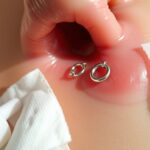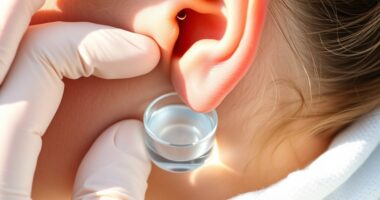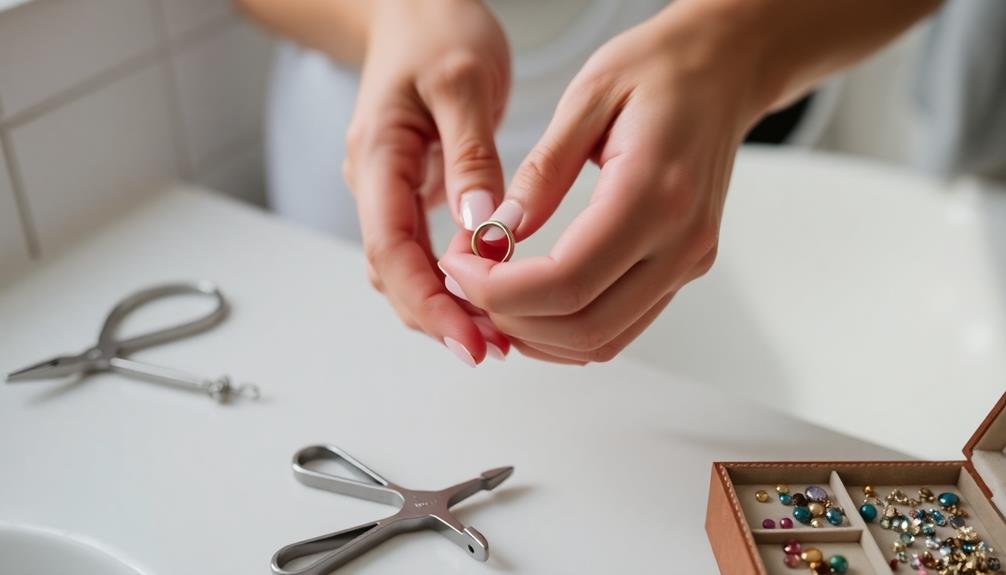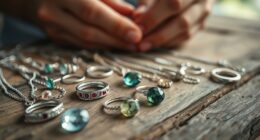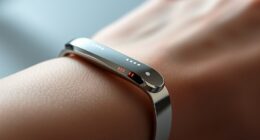To care for piercings in humid climates, you need to be extra vigilant. Clean your piercings with a saline solution twice daily and after sweating. Pat the area dry with a clean cloth to reduce moisture, and try sea salt soaks a couple of times a week. Wear breathable, loose-fitting clothing to minimize irritation. Limit swimming and always rinse your piercings after water exposure. Keep a close eye on any signs of infection, like redness or swelling. By staying attentive and adjusting your routine based on the weather, you'll guarantee ideal healing. There's plenty more to discover about effective care methods.
Key Takeaways
- Clean piercings twice daily with saline solution and pat dry with a clean cloth to prevent moisture buildup and bacteria growth.
- Wear breathable, loose-fitting clothing made of natural fibers to minimize friction and moisture around the piercing.
- Limit swimming in lakes, rivers, or oceans during the healing process and rinse with clean water after exposure to contaminated water.
- Monitor for signs of irritation or infection, and seek medical advice if redness, swelling, or unusual discharge occurs.
- Adjust aftercare routines based on local humidity levels, increasing cleaning frequency in high humidity conditions.
Climate's Impact on Healing

When it comes to healing piercings, climate plays a significant role, especially in humid environments. High humidity can prolong your healing process since the excess moisture and sweating create a perfect breeding ground for bacteria.
This moist atmosphere can irritate your piercing, leading to inflammation, increased swelling, and discomfort.
To prevent complications, maintaining proper hygiene is essential. Regularly clean your piercing with clean tap water to help minimize the risk of infections.
In humid conditions, consider using longer initial jewelry posts to accommodate potential swelling and reduce irritation.
You should closely monitor your piercing for any signs of infection or increased irritation. If you notice unusual redness, warmth, or pus, seek medical advice promptly.
Seasonal Considerations for Care
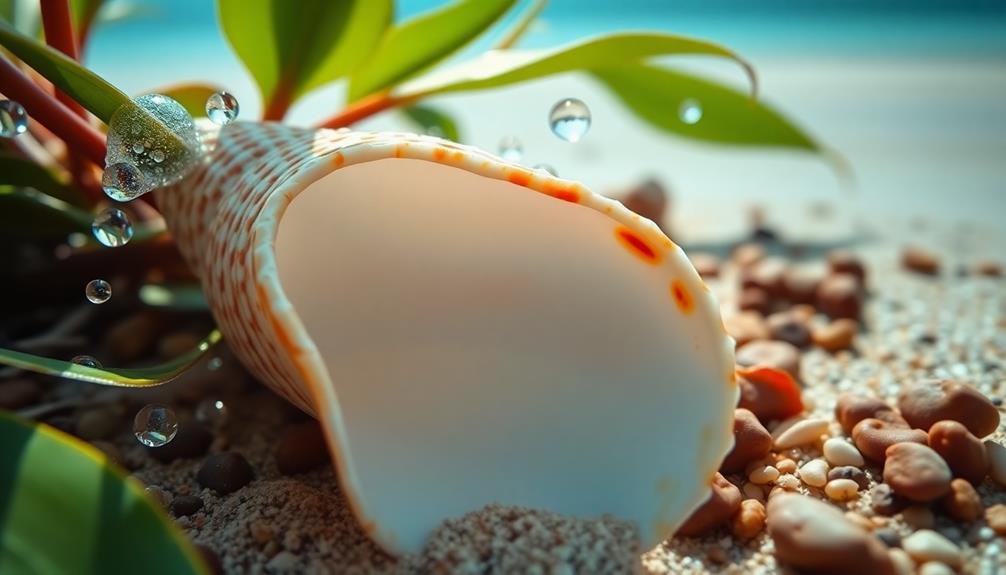
When seasons change, so should your piercing care routine.
Humidity can slow healing and increase irritation, making it essential to monitor how your environment affects your piercings.
Adjusting your clothing and activities can help keep your piercings clean and comfortable throughout the year.
Humidity's Impact on Healing
Humidity can greatly affect the healing process of your piercings, especially during warmer months. High humidity levels can prolong healing time due to increased moisture and sweating, which raises the risk of infection.
Excessive sweating creates a moist environment that irritates healing piercings and can lead to inflammation. You may notice that humidity exacerbates initial swelling, so it's important to monitor and manage these symptoms closely.
To promote healing, you'll need to adjust your aftercare routine. Increase the frequency of cleaning your piercings to remove sweat and bacteria. Use a gentle saline solution to clean the area, ensuring you don't introduce new irritants.
Additionally, wearing breathable clothing can help reduce friction and irritation around the piercing site.
Seasonal Activity Adjustments
Adjusting your activities according to the season can greatly enhance your piercing care routine. In humid climates, managing your physical activity is essential for fresh piercings. Excess moisture can prolong healing, so it's best to be strategic about when and how you engage in certain activities.
| Season | Recommended Activities | Activities to Avoid |
|---|---|---|
| Spring | Light walks, yoga | Strenuous outdoor sports |
| Summer | Early morning or evening walks | Peak humidity outdoor activities |
| Fall | Hiking, light cardio | Excessive sweating sessions |
| Winter | Indoor workouts | Cold weather exposure |
| Year-round | Regular piercing aftercare | Neglecting cleanliness |
During the summer, keep an eye on your piercing for signs of irritation or infection. Increased sweating can lead to moisture-related issues, so make sure to dry the area around your piercing regularly. Also, schedule your piercing aftercare appointments during cooler parts of the day to avoid swelling and discomfort. By adjusting your seasonal activities, you can help maintain the health and appearance of your piercings.
Clothing and Piercing Care
How can your clothing choices impact the healing process of your piercings? In humid climates, breathable fabrics are essential. They help reduce moisture buildup around your piercings, decreasing the risk of irritation and infection.
Opt for loose-fitting clothing to minimize friction on your healing piercings; this prevents additional trauma and promotes proper healing.
Avoid tight accessories like hats or collars, as they can trap heat and moisture, complicating the healing period. Instead, choose moisture-wicking materials that manage skin health and support healing.
Regularly washing your clothing is vital too, especially items that come into contact with your piercings. Clean clothing eliminates bacteria and sweat, which can lead to infections in humid environments.
Managing Moisture Levels
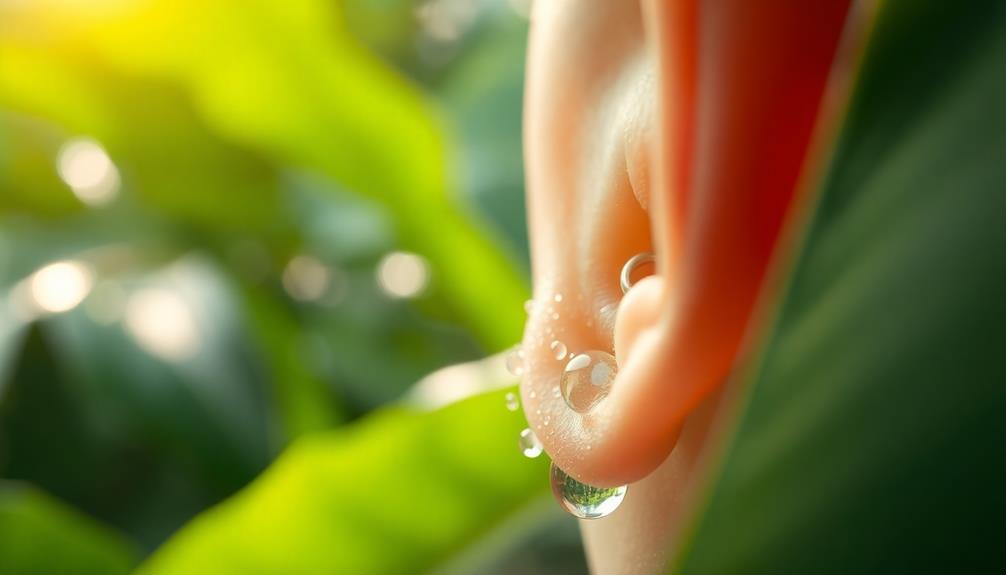
When it comes to managing moisture levels for your piercings, humidity plays a significant role in the healing process.
You'll want to keep an eye on your sweat levels and choose breathable clothing to avoid irritation.
Regular cleaning with saline solution will also help keep excess moisture and bacteria at bay, ensuring a smoother healing journey.
Humidity's Healing Impact
Humidity plays a significant role in the healing process of your piercings, and managing moisture levels is fundamental for a successful recovery. In humid climates, high moisture can prolong healing times, increasing the risk of infections and irritation.
To combat these issues, it's essential to keep your piercings clean. Rinse them regularly with clean water and use an aftercare solution, such as saline, to help prevent complications.
Breathable clothing is your friend; avoid tight accessories that can trap moisture around your piercing. This simple step will promote healthier healing by reducing moisture accumulation.
Additionally, keep an eye out for any signs of irritation or infection. The warm, moist environment can worsen existing skin issues, so regular checks are critical.
If you notice any redness, swelling, or unusual discharge, address it immediately to avoid further complications.
Sweating and Piercing Care
Excessive sweating can complicate the healing of your piercings, creating a moist environment that heightens the risk of infection and irritation. To manage moisture levels, follow these essential steps:
| Action | Description | Importance |
|---|---|---|
| Rinse your piercing | Use a saline solution after sweating. | Prevents bacteria buildup and maintains hygiene. |
| Pat dry | Gently dry the area with a clean cloth. | Reduces excess moisture that can cause complications. |
| Monitor for irritation | Check for redness, swelling, or discomfort. | Early detection helps prevent serious issues. |
| Wear breathable clothing | Choose fabrics that allow air circulation. | Minimizes sweat accumulation around the piercing. |
Clothing Choices for Comfort
Choosing the right clothing can greatly enhance your comfort while caring for piercings. In humid climates, opt for breathable, moisture-wicking fabrics that help manage sweat and moisture around your healing piercings. This can notably reduce the risk of irritation and infection, especially when considering the benefits of essential oils for skin health, which can complement your care routine.
Loose-fitting clothing is also essential; it prevents friction against your piercings, which is particularly important in hot weather when sweating can exacerbate irritation. Natural fibers like cotton and linen are your best bets. They allow for better air circulation and keep your skin dry, unlike synthetic materials that can trap moisture.
Additionally, avoid tight accessories or jewelry that may rub against your piercings. High humidity can lead to swelling and increased sensitivity, so it's best to keep things loose.
During outdoor activities, consider wearing protective coverings like soft bandages or clothing over your piercings. This shields them from excessive moisture and environmental irritants, further aiding in the healing process.
Essential Aftercare Practices

Proper aftercare is essential for ensuring your piercings heal well and remain infection-free. In humid climates, cleanliness is key. Rinse your fresh piercing with saline solution or clean water twice daily to prevent moisture-related infections. After sweating, pat the area dry with a clean, soft cloth. You'll also want to wear breathable clothing and avoid tight accessories that can trap moisture around the piercing.
To promote healing, incorporate sea salt soaks into your routine. Soak for 5-7 minutes with a non-iodised sea salt solution at least twice a week. Regularly check your piercing for signs of irritation or infection, like increased redness or discharge, and consult a professional piercer if any concerns arise.
Here's a quick reference table to help you remember essential aftercare practices:
| Aftercare Practice | Frequency |
|---|---|
| Rinse with saline solution | Twice daily |
| Pat dry after sweating | After every activity |
| Sea salt soaks | Twice a week |
| Monitor for irritation | Daily |
Swimming and Water Exposure
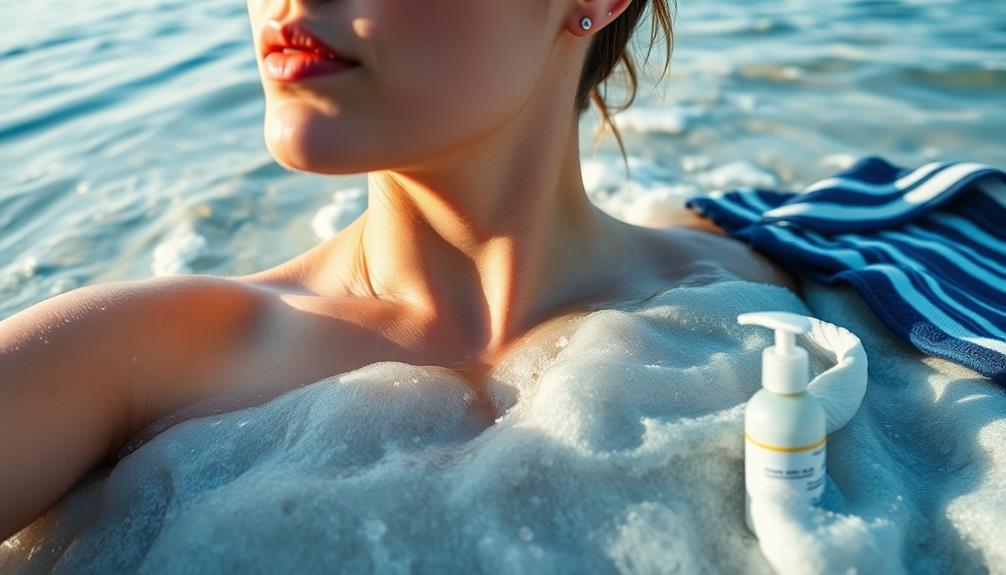
When caring for your new piercings, staying mindful of water exposure is crucial for ideal healing. In humid climates, you should avoid swimming in bodies of water like lakes, rivers, or oceans. These environments can introduce harmful bacteria, increasing your risk of infection during the healing process.
Limit swimming activities for at least the first few weeks after getting your piercing to guarantee optimal healing and reduce complications related to moisture exposure. If you accidentally expose your piercing to contaminated water, rinse it with clean water immediately to minimize irritation and infection risks.
If you're considering chlorinated pools, keep in mind that chlorine can irritate healing piercings. It's best to wait until your piercing is fully healed before diving in.
After swimming, always reapply your aftercare solution to maintain cleanliness and support healing. Moist environments can lead to prolonged healing times, so protecting your piercing is imperative.
Sun Protection Strategies

Protecting your new piercing from the sun is fundamental for a smooth healing process. In humid climates, applying sunscreen to the skin around your piercing is important, but steer clear of the piercing site itself to prevent irritation. Instead, use a mirror to apply sunscreen precisely to the surrounding skin, ensuring that you maintain effective protection without compromising your piercing's healing.
Wearing a wide-brimmed hat can also help shield your piercing from direct sunlight, reducing the risk of irritation and discoloration. Remember, prolonged sun exposure can increase the likelihood of infection, especially for new piercings. So, try to limit your sun exposure during the healing phase to keep your skin healthy.
Staying hydrated in humid conditions is another fundamental strategy. Proper hydration supports overall skin health, which is crucial for peak healing of piercings exposed to high temperatures and moisture.
Hygiene and Health Guidelines
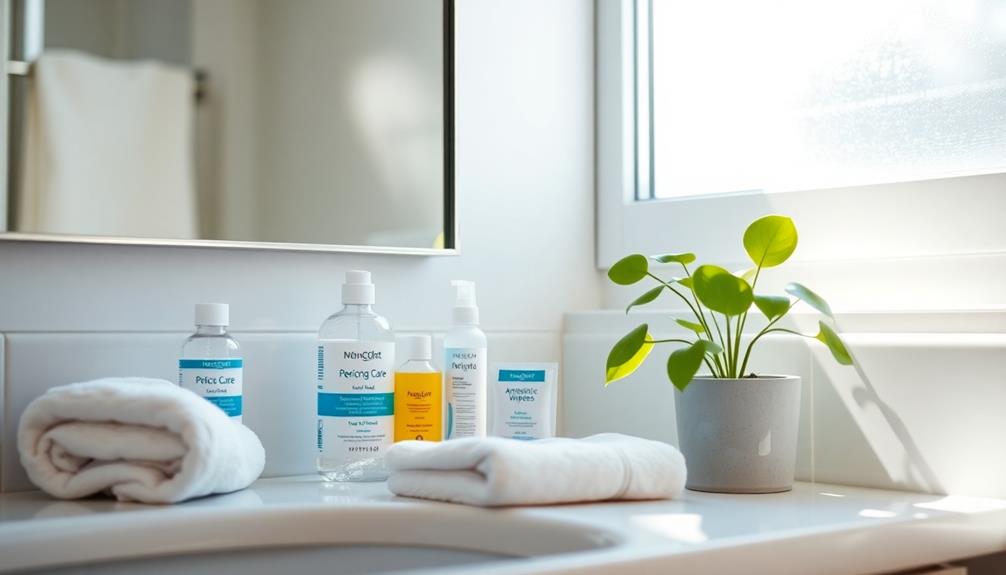
To guarantee your piercing heals well, maintaining high hygiene standards is key. In humid climates, it's essential to clean piercings regularly with saline solution to prevent moisture-related infections and irritation caused by excessive sweating.
Always wash your hands thoroughly before touching or cleaning your piercings, as this limits the introduction of bacteria and contaminants.
Stay vigilant by regularly monitoring your piercing for signs of irritation or infection, such as redness or swelling. If you notice any unusual symptoms, don't hesitate to seek professional advice.
Proper hydration also plays a significant role in healing; drink plenty of water to support skin health and help your body recover more effectively.
Choose breathable clothing and avoid tight accessories that can trap moisture around the piercing. This simple step reduces the risk of inflammation and infection, ensuring your piercings stay clean and healthy.
Staying Informed About Care

Staying informed about your piercing care is essential, especially in humid environments where moisture can complicate healing. High humidity can prolong healing times and increase the risk of infections due to sweating and skin irritations.
It's highly recommended to regularly monitor local humidity levels so you can adjust your piercing care routine accordingly. For instance, you might need to increase your cleaning frequency or avoid tight clothing that traps moisture around the piercing. Additionally, consider using products like cute acne patches to brighten skin to help soothe any irritation that may arise from humidity.
Be certain to engage with professional piercers and follow their social media updates for valuable insights into best practices and common issues faced in humid climates. They often share tips tailored to specific weather conditions.
Additionally, utilizing breathable fabrics and moisture-wicking clothing can minimize irritation and promote better air circulation around your healing piercings.
Keep in mind that attending workshops or seeking educational resources on piercing maintenance can greatly enhance your understanding of how to care for your piercings effectively. Staying proactive and educated about your piercing care will help guarantee a smooth healing process and reduce the risks associated with a humid environment.
Frequently Asked Questions
Does Humidity Affect Piercings?
Yes, humidity can affect piercings. It creates a moist environment that increases infection risk and inflammation, prolonging healing time. You'll need to stay vigilant about cleanliness and monitor for any signs of irritation or infection.
Does Weather Affect Piercing Healing?
Yes, weather definitely affects piercing healing. Changes in temperature and humidity can lead to increased irritation and swelling. You should monitor your piercings closely and adjust your aftercare routine based on the weather conditions.
Is Sweating Bad for a New Piercing?
Sweat trickles down your skin, pooling around your new piercing. Yes, sweating can be bad; it creates a moist environment, increasing infection risk. Gently clean the area to keep it healthy during healing.
Does Heat Affect Piercings?
Yes, heat does affect piercings. It can cause increased swelling and irritation, prolong healing, and raise infection risks. Keeping your piercings clean and monitoring for issues is essential in warm conditions to guarantee proper recovery.
Conclusion
In humid climates, taking care of your piercings is vital for a smooth healing process. Did you know that nearly 40% of piercing complications stem from improper aftercare? By managing moisture levels, following essential aftercare practices, and protecting your piercings from the sun and water, you can greatly reduce the risk of infection and irritation. Stay informed and proactive in your care routine to enjoy your new look without the hassle of healing issues!





